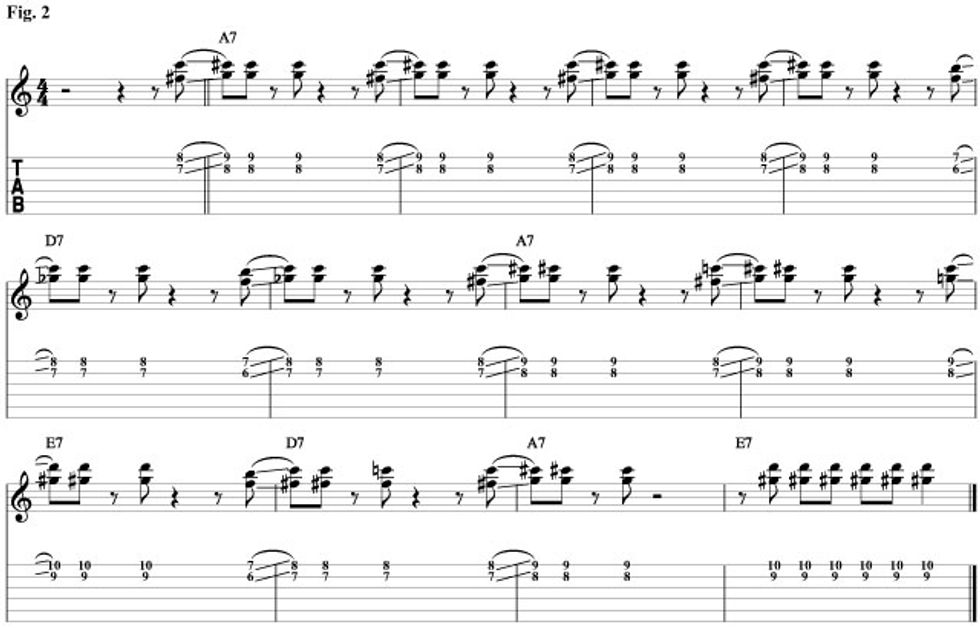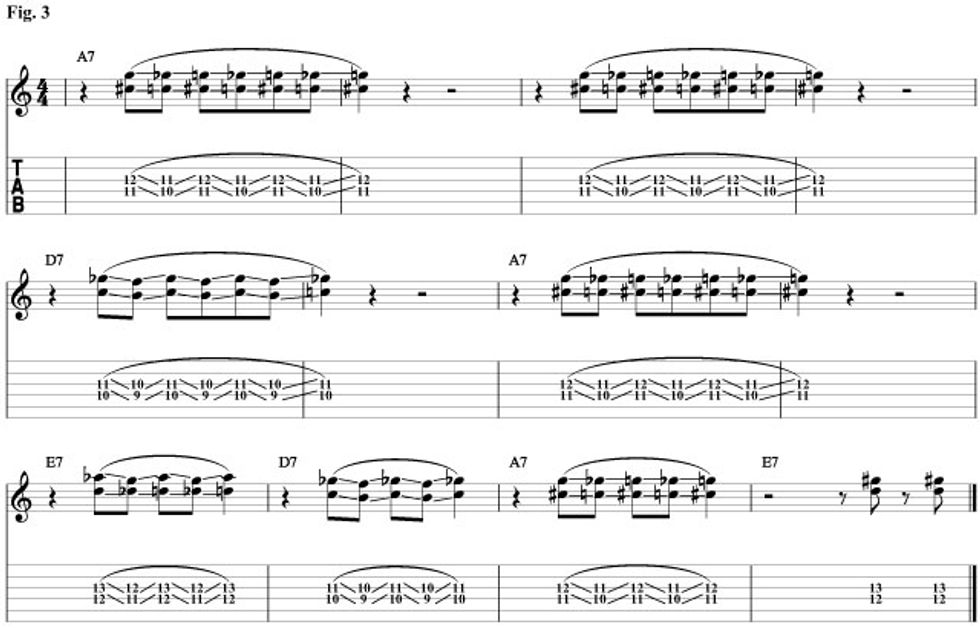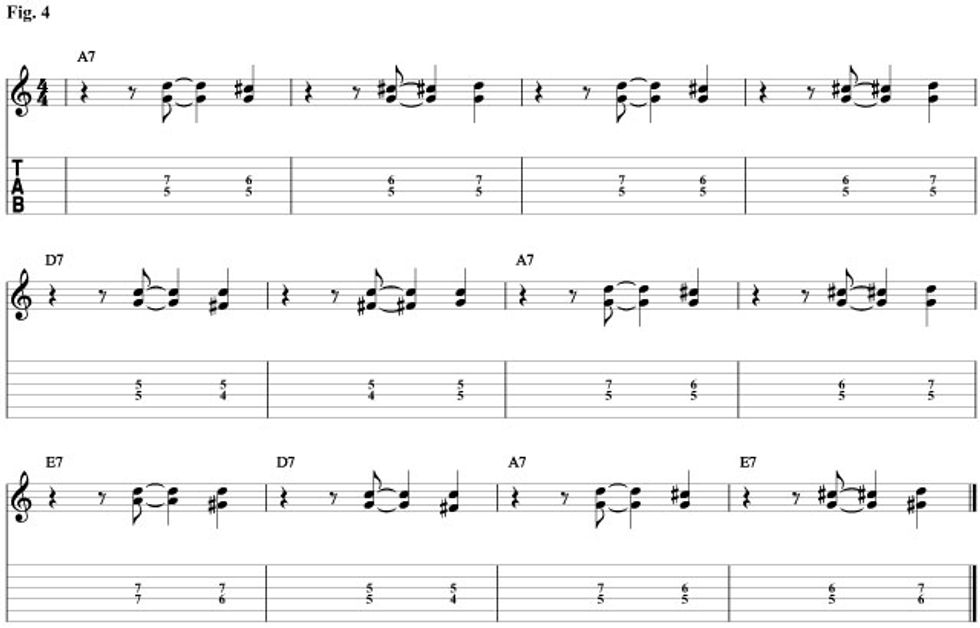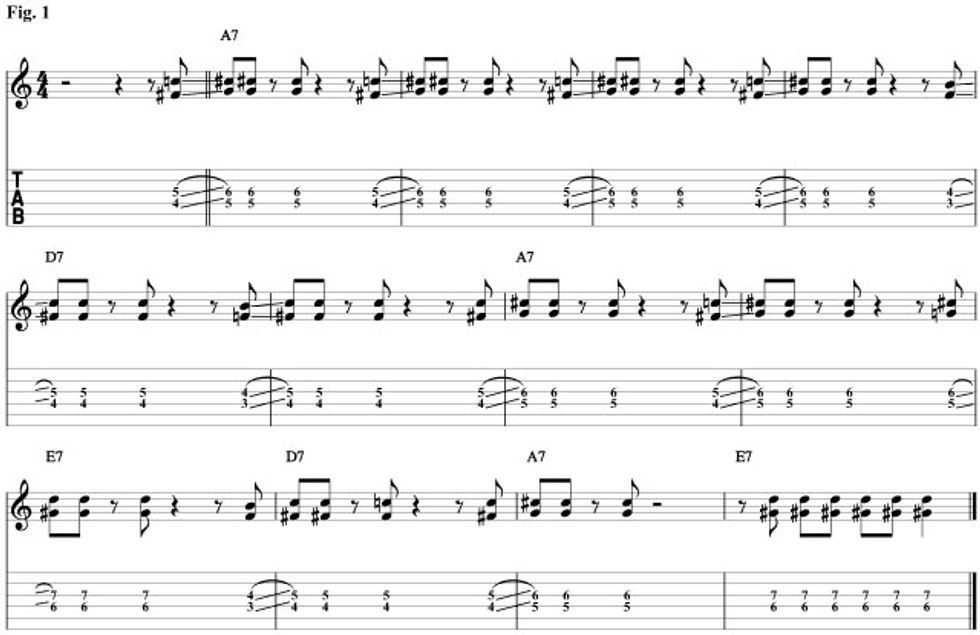Rhythmic styles based in horn and piano parts of Albert King and James Brown tunes.
In this month’s column we’ll continue our look at target tones. Target notes not only function as cool notes to land on when soloing but they also function as the more valuable notes within a chord. If the bass player is already playing the roots, then all you need to play is the 3rds and 7ths to complete the sound. One of my favorite examples of these in a blues is Albert King’s version of “Cross Cut Saw.” The piano player is playing the coolest rhythm with just 3rds and 7ths. Then the horn section comes in playing these really cool hits, again just using the same notes. There are a lot of cool examples of this sound all over the blues, just keep you ears open and you’ll hear it. Again, we’ll use the key of A for the following examples. We’ll also stick with just the three chords I (A7), IV (D7), and V (E7).
Fig. 1 is based on the piano part in “Cross Cut Saw.” The idea is, as I said before, the 3rds and 7ths of each of the three chords being played in a rhythmic style. But the cool thing is how you can slide these target tones up and down the fretboard to create tension. The funny thing is that the distance between these two notes creates a tritone, probably the most tension filled interval available. So moving them up and down to create even more tension is really fun. This gives an improvisational aspect to your rhythm playing that you don’t get when your only playing full bar chords. We’ll start out with the I chord. The 3rd of A7 is C# and the 7th is G. When we move to the IV chord (D7) the 3rd is F# and the 7th is C. If we look close we’ll see that F# is a half step below G, and C is a half step below C#. So all we’ll do is move our I chord rhythm down a half step when we move to the IV chord in measure five. For the V chord (E7) the third is G# and the seventh is D. This means that all we'll have to do for the V chord is move our I chord rhythm up a half step. Check out how we’re sliding in to each of the target tones from a half step below. Listen to how that creates cool tension and release.
Download Example Audio...
Fig. 2 is influenced by the horns in Albert King’s “Cross Cut Saw.” It’s the same notes as Fig. 1, the only change is that I moved the notes up an octave and I’ve changed the rhythm to more of a short, choppy rhythm you might hear a horn section play. Download Example Audio...

Fig. 3 is influenced by the horn part in James Brown’s “I Feel Good.” This is still a blues in the key of A. I’ve moved up the neck of the guitar to play the third’s and seventh’s off of the 5th string root A7 at the twelfth fret. Another difference you might hear is that our starting interval has the 3rd on the bottom and the flat 7th on the top. Download Example Audio...

Fig. 4 is more of a relaxed way to comp using the target tones. In this example we’re going to get a little fancy. We are going to suspend the 3rds. This is a really cool jazzy sound. To sus (suspend) a chord all you do is either raise the third up or down a scale degree and then resolve to the 3rd. When you raise the 3rd up a scale degree you create a sus4 chord. So, we’re going to create sus4 chords to use in the blues. For the A7 chord we’ll raise the C# up to D. On D7, the 3rd is F# and the flat 7th is C. Here, we will raise the F# up to G. Finally, for E7, we will raise the G# to A. You should notice that the 3rds started out on the third string for the I chord then moved to the fourth string for both the IV and V chords. You should also notice that the sus4 is only half step up. Download Example Audio...

Try making up your own rhythms and even combining a few of these examples. Rhythm guitar is so important and it is what we really spend the most time doing when playing with others. It get’s really boring when you play the same rhythm over and over for five or ten minutes. If you apply these examples to your playing you’ll have fun and maybe even like playing rhythm.
Take your time with these examples. Pay close attention to the rhythm of each of them. Most importantly, listen to others as you play. Try to play in the spaces and remember to leave space for others to play in.
‘til next time enjoy and have fun. Thanks for reading.
Dennis McCumber has been a guitar instructor and performer for more than 20 years. He holds a Bachelor’s degree in Music Education from The College of Saint Rose and performs regularly in the New York City area. Since 1996 he has been on faculty with the National Guitar Workshop where he teaches blues, rock and funk. Find out more about Dennis at dennismccumber.com

